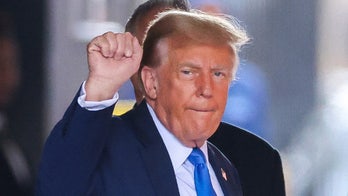
April 13: President Barack Obama outlines his fiscal policy during an address at George Washington University in Washington. (AP)
Unveiling his plan to cut the national debt by $4 trillion over the next 12 years, President Obama noticeably stumbled over the part of his carefully crafted speech that revealed his core philosophy about income taxes.
The original wording, provided to news media outlets on an embargoed basis, called for the president to reaffirm his belief that “those who have benefited most from our way of life can afford to give a bit more back.” But when he delivered the speech at the George Washington University on Wednesday afternoon, reading the text with the aid of a teleprompter, Obama stammered momentarily as he asserted that “those who benefited most from our way of life can afford to give back a little -- a little bit more.”
All public speakers occasionally muff their lines – TV correspondents included. But in this case, it was almost as though the president realized in mid-sentence how politically risky his plan is, and how much he was exposing himself anew, at the dawn of his re-election campaign, to old and familiar charges that he aims to soak the rich to benefit the poor.
To bolster federal revenues under his plan, Obama vowed to eliminate the Bush-era tax cuts for America’s top income earners, which are set to expire at the end of 2012. In a compromise with congressional Republicans four months ago, the president signed into law a temporary, two-year extension of those cuts. Today he vowed: Never again.
“It was the only way I could prevent a tax hike on middle-class Americans,” Mr. Obama said. “But we cannot afford $1 trillion worth of tax cuts for every millionaire and billionaire in our society. And I refuse to renew them again.”
Appealing to Americans’ sense of themselves as a fair and generous people, the president cited statistics reflecting an egregious inequity in income distribution in the United States. “Think about it,” he said. “In the last decade, the average income of the bottom 90 percent of all working Americans actually declined. The top 1 percent saw their income rise by an average of more than a quarter of a million dollars each. And that’s who needs to pay less taxes?”
Yet statistics show that the top 1 percent of American income earners already carry a disproportionate share of the country’s tax burden. Figures provided by the non-partisan National Taxpayer Union, citing Internal Revenue Service data, show that in 2008, the top 1 percent of U.S. income earners – those making at least $380,000 a year – accounted for 38 percent of all taxes paid. At the same time, the bottom 50 percent of earners – those earning $33,000 or less – contributed less than 3 percent to the IRS’ coffers.
If the Bush-era tax cuts are permitted to lapse, the top marginal rate would rise from 35 to 39.6 percent, a prospect congressional Republicans say would amount to a massive tax hike on small businesses.
“About 80 percent of companies in America pay their taxes as individuals, not as companies,” Sen. Rob Portman, R-Ohio, a member of the Senate Budget Committee, told FOX News. “So if you raise taxes, as he proposes to do by allowing the tax relief to expire, he's going to be raising taxes on a lot of business owners. In fact, about half the income that would get additional taxation is small business income. These are the very businesses that we are relying on to help get the economy moving again.”
An alternative plan unveiled on April 5 by Rep. Paul Ryan, R-Wisc., the chairman of the House Budget Committee, proposes to trim the debt by $6 trillion over ten years, and sets the top tax rate for individuals and businesses at 25 percent. Still another plan, put forward late last year by the National Commission on Fiscal Responsibility and Reform, a bipartisan blue-ribbon panel appointed by President Obama, called for a top tax rate between 23 and 29 percent.
All of these plans envision different changes to the vast universe of exemptions and tax breaks exploited by individuals and businesses; and they all employ different assumptions about the other side of the federal budget ledger – namely, spending.
“How do you expect to help the job seeker by yet again punishing the job creator?” asked Rep. Jeb Hensarling, R-Tex., after the president’s speech. “I know of no nation that has ever taxed its way into economic prosperity.”
“We have been down this so-called path to prosperity before,” countered Rep. Steny Hoyer (D-Mary.), the number-two Democrat in the House, invoking the title of Ryan’s plan. “It leads to skyrocketing deficits because the supply-side dogma that lower taxes mean higher revenues has proven false over the last three decades.”
These debates echo those heard again and again in the 2010 midterm season, and still more during the subsequent lame-duck Congress that ended with the president temporarily extending the Bush-era tax cuts for all income brackets.
With his gambit today, the president ensured the legislation signed into law by his predecessor in 2001 and 2003 will figure prominently in the next election cycle, as well.
The latest FOX News poll, conducted last week by a pair of Democratic and Republican research firms, found registered voters split on the fairness of their tax burdens. Some 52 percent of those surveyed said they pay the right amount in taxes, with 43 percent saying they pay more than their fair share. Upper income earners tended to believe themselves overburdened by taxation, while those making less than $50,000 a year were inclined to say they are paying their fair share.
The poll was conducted by telephone between April 3-5 among 914 randomly chosen registered voters, and carries a margin of error of 3 percent.




